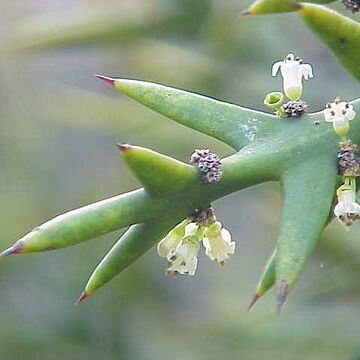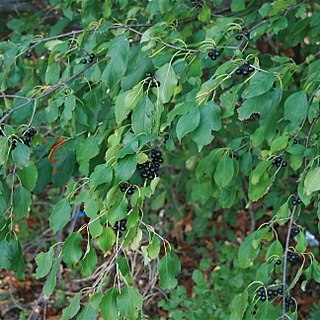Deciduous or evergreen, often thorny trees, shrubs, woody climbers, or lianas, rarely herbs. Leaves simple, petiolate, alternate or opposite, pinnately veined or 3-5-veined, entire to serrate, sometimes much reduced; stipules small, caducous or persistent, sometimes transformed into spines. Flowers yellowish to greenish, rarely brightly colored, small, bisexual or unisexual, rarely polygamous, (4 or)5-merous, hypogynous to epigynous, in mostly axillary, sessile or pedunculate cymes, or reduced to few in fascicles. Calyx tube patelliform or hemispherical to tubular, sometimes absent, at rim with calyx, corolla, and stamens; sepals 4 or 5, valvate in bud, triangular, erect or ± recurved during anthesis, adaxially often distinctly keeled, alternate with petals. Petals 4 or 5, rarely absent, usually smaller than sepals, concave or hooded, rarely nearly flat, often shortly clawed. Stamens 4 or 5, antepetalous and often ± enclosed by petals; filaments thin, adnate to bases of petals; anthers minute, versatile or not, 2(or 4)-celled, dehiscing by longitudinal slits, usually introrse. Disk intrastaminal, nectariferous, thin to ± fleshy, entire or lobed, glabrous or rarely pubescent, free from ovary or tightly surrounding it, or adnate to calyx tube. Ovary superior to inferior, (1 or)2-4-loculed, with 1(or 2) ovules per locule; ovules anatropous, basal and erect; styles simple or ± deeply 3-lobed or 3-cleft. Fruit either an indehiscent, rarely explosively dehiscent, sometimes winged, schizocarpic capsule, or a ± fleshy drupe with 1-4 indehiscent, rarely dehiscent, pyrenes (stones). Seeds with thin, oily albumen, sometimes exalbuminous; embryo large, oily, straight or rarely bent.
Shrubs, trees, or woody vines, [herbs, annual or perennial], evergreen or deciduous, synoecious, dioecious, or polygamous [monoecious], sometimes armed with thorns or stipular spines. Leaves alternate, fascicled, clustered, or opposite, simple; stipules present; petiole present (absent in Condalia); blade margins entire, serrate, serrulate, crenate, crenulate, dentate, or denticulate, sometimes spinose or spinulose; venation pinnate (sometimes obscurely, appearing 1-veined) or 3[–5]-veined from base (acrodromous). Inflorescences bisexual or unisexual, axillary or terminal, fascicles, umbels, panicles, cymes, or thyrses (these sometimes spikelike, racemelike, or paniclelike), or flowers solitary. Flowers bisexual or unisexual; perianth and androecium epigynous or perigynous [hypogynous]; hypanthium free or adnate to ovary proximally and free distally [absent]; sepals [3–]4–5(–8), distinct, valvate; petals 0 or [3–]4–5(–8), distinct; nectary present, intrastaminal, sometimes lining hypanthium; stamens [3–]4–5(–8), opposite petals, distinct, adnate to petal bases; anthers dehiscing by longitudinal slits; pistil 1, 2–4-carpellate, ovary superior to inferior, (1–)2–4-locular, placentation basal; ovules 1 per locule (2 per locule in Karwinskia), anatropous; styles 1–4, connate proximally to completely; stigmas 1–4. Fruits capsules, dehiscence loculicidal, schizocarps, samaras, or drupes. Seeds 1 (sometimes 2 in Karwinskia) per locule.
Shrubs, trees or lianes (rarely herbs outside Australia), perennial, usually with simple, bifid or stellate, non-glandular hairs at least on young growth. Leaves simple, alternate (rarely opposite), usually symmetric (oblique in Ziziphus); stipules present or sometimes almost lacking, sometimes spiny. Inflorescences terminal or axillary, bracteate, cymose but sometimes appearing racemiform or paniculate or reduced to dense heads, few-flowered clusters or single flowers. Flowers small, usually bisexual and protandrous, actinomorphic, 4-or 5-merous. Hypanthium funnel-shaped to shallowly dish-shaped, sometimes extended into a distinct tube. Sepals valvate, usually adaxially keeled. Petals usually clawed, often small and hood-like, sometimes absent. Stamens isomerous with the sepals, opposite the petals and often enclosed by them; anthers 2-locular, dorsifixed, introrse, longitudinally dehiscent. Disc usually conspicuous, filling or lining the hypanthium or forming a ring around the summit of the ovary or a shelf at the apex of the hypanthium. Ovary at anthesis half-to fully-inferior (sunk in the disc), rarely superior; carpels 2–5; ovule one per loculus, erect; style almost entire to deeply divided. Fruit a capsule, schizocarp, drupe or samara. Seeds usually arillate with a large embryo and scanty endosperm.
Disk usually present and well developed, intrastaminal, perigynous, very variable in shape, large, filling the receptacle or cup-shaped with free margins, or lining the receptacle; ovary syncarpous, sessile, free or immersed in the disk, superior, subinferior or inferior, 2–4-locular; style entire or 2–4-lobed; ovules solitary in each loculus, erect, anatropous
Trees, shrubs, shrublets or lianes, glabrous or with simple hairs; branches rarely with coiled tendrils; leaves alternate or rarely opposite, simple, entire to toothed, petiolate, penninerved or 3–5-nerved from the base; stipules present, rarely interpetiolar, sometimes spinescent
Flowers often in axillary cymes or umbels (rarely solitary), or in racemes arranged in terminal panicles or thyrses, bisexual (rarely unisexual), actinomorphic
Ovary sessile, superior or subinferior, 2–4-celled; ovules solitary or rarely paired, erect from the base, anatropous
Stamens (4) 5, antipetalous; filaments free; anthers 2-thecous (rarely 1-thecous), introrse, dehiscing longitudinally
Petals (4) 5 or absent, usually smaller than the sepals and unguiculate, cucullate, closely surrounding the stamens
Fruit a drupe or septicidal capsule or schizocarp, (1)2–3(4)-locular, sometimeswinged
Seeds 1 in each loculus; embryo large, straight; endosperm usually copious
Flowers often cymose or fasciculate, small, hermaphrodite or polygamous
Stamens 4–5, opposite the petals; anthers 2-celled, opening lengthwise
Seeds mostly with copious endosperm and large straight embryo
Leaves simple, alternate or opposite; stipules mostly present
Receptacle flattish to obconic or hemispherical
Trees or shrubs, sometimes climbing
Disk mostly present, perigynous
Fruit various, often drupaceous
Petals 4 or 5, small, or absent
Sepals (4) 5, valvate
Calyx-lobes valvate


